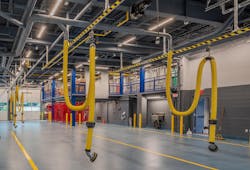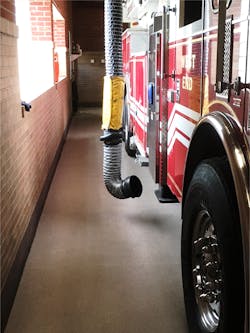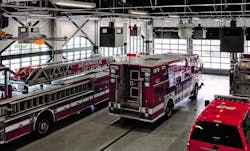The Ins and Outs of Vehicle Exhaust Extraction Systems
When speaking about first responders, we often refer to the service that they provide and how they protect the public. It’s equally important to understand how leadership and design professionals can protect these people from the dangers of their profession.
Of course, the fire service is aware of the hazards, and not only on the fireground but inside of the fire station, too. Indoor air quality has been a primary focus for studies and advances in technology, and those significantly improved the cleanliness of the air that’s within the station and, thus, provided safer working conditions.
Since 1970, when the United States passed the Clean Air Act and created the Environmental Protection Agency to enforce it, significant research has been undertaken. In 1988, the National Institute for Occupational Safety and Health (NIOSH) issued “Current Intelligence Bulletin 50.” The document describes the workplace hazards that are presented by diesel engine emissions, and studies confirmed the potential carcinogenicity of whole diesel exhaust. With this understanding, diesel exhaust is regarded as a potential occupational carcinogen.
More than 30 years later, the occurrences of cancer and respiratory illnesses continue to grow because of the ingestion and absorption hazards of particulates and gases from diesel emissions. Other hazards include firematic operations, contaminated PPE, tools and equipment, and, finally, building layout and design.
The NFPA published NFPA 1500: Standard on Fire Department Occupational Safety, Health, and Wellness Program, which indicates “the fire department shall prevent exposure to fire fighters and contamination of living and sleeping areas from exhaust emissions,” making this issue a top priority.
To counteract the transmission of these hazards, emergency response architects and engineers started rethinking common practices and operating procedures for emergency services clients through improving building layouts and design. The floor plan, materials and building systems all can have a significant effect on mitigating cross-contamination and on providing protection from carcinogens.Weren’t hazards addressed?
It’s a false assumption that opening the overhead doors before starting apparatus allows enough air flow to clear out the diesel exhaust. Incorrect assumptions such as this can become commonplace in the fire service and be the culprit for current contamination and possible future illness.
After 2007, diesel particulate filters (DPF) were required to be installed in new apparatus. This is sufficient to make it safe to be in close proximity to the exhaust, correct? Another incorrect assumption. It’s dangerous to misunderstand the steps and measures that the industry has taken to reduce emissions of greenhouse gasses. Although these advancements in technology helped to reduce the air pollution, when it comes to the atmosphere that’s within the station, diesel exhaust still is dangerous, and additional engineering and systems still are required to clean the air.Addressing the hazards
NIOSH indicates the dangers of the cancer-causing diesel fumes. There are several types of vehicle exhaust (VEX) removal systems, each unique in its own way. As one would expect, each has pros and cons regarding the capture, treatment and/or filtration of the exhaust.
The three primary VEX system options are (in no particular order):
- Hose-based direct source capture
- Vehicle-mounted direct source capture
- Building-space filtration
Hose-based direct source capture
Direct source capture systems utilize a hose to capture diesel fumes directly from the apparatus exhaust: Diesel exhaust doesn’t enter the atmosphere within the building, because it’s redirected to the exterior. The exhaust is removed from the building entirely via hoses, a network of ductwork and an exhaust fan(s). These systems can be designed for all apparatus, large and small, with various exhaust pipe locations.
Although the hose is attached to the exhaust pipe and the vehicle is started, the system is triggered and runs for a preset amount of time, including once the hose is disengaged, to ensure that all of the remaining particulates and exhaust are removed from the hose and ductwork prior to shutting down.
The hose is attached to the exhaust pipe via magnetic grabbers and anchor plates. This is notable, because earlier versions of these systems utilized a pneumatic bladder that sometimes had trouble disengaging as the apparatus exited the bay. The bladder would remain attached to the tailpipe, and the hose would be torn and dragged down the street.
Vehicle-mounted direct source capture
With vehicle-mounted direct source capture systems, exhaust is filtered directly on the apparatus and then released within the building atmosphere. This process takes place within a special filtration chamber along the existing vehicle exhaust system. On some models, a specialized diverter redirects the vehicle exhaust while the apparatus is in the building and requires filtration. On the newest versions of vehicle-mounted direct source capture systems, the filter requires no diverter, and filtration always is taking place. The byproduct of the filtered exhaust reduces the hazards to an acceptable level for breathing within the space.
Systems that typically require diversion utilize electronic control devices to activate. These systems aren’t utilized just when entering and exiting the station but even on scene. During fire operations on scene, conditions often exist in which firefighters and other emergency personnel are subjected to prolonged exposure to diesel exhaust as apparatus operate (i.e., an engine pumping for the duration of a fire). These systems can be activated to provide safer on-scene conditions, which aligns with many other current trends and initiatives to prevent cross-contamination on scene. The newest versions provide this added protection automatically.
Building-space filtration
Building-space filtration systems differ from the previous two systems in that they aren’t a direct source capture system. Building-space filtration systems typically are ceiling units that have a fan that forces air through a series of filters, effectively scrubbing the air clean of diesel particulates and absorbing other harmful exhaust components. These systems are automatic, self-contained and hose-less.
Over recent years, the design of these systems evolved, including the development of the capability to address airborne viruses and bacteria. This has been a huge benefit to first responders, particularly in EMS stations. Furthermore, with the emergence of COVID-19, space filtration and decontamination have become an even greater concern.
Another added bonus to building-space filtration systems is the fact that the systems’ filters also scrub emissions from smaller engines (nondiesel). Operations in a fire station often include running gasoline-powered saws, generators, lights, extrication tools, etc., during cleanup and inspection. Although the small engines on these pieces of equipment should be operated on the exterior of the station, they often end up being run within the apparatus bay as a convenience, possibly because of cold weather, rain or snow. Building-space filtration systems, at a minimum, help to address these hazards within the building atmosphere.
The operation of these systems is automatic. Sensors detect vehicle and/or door movement and activate automatically. Once activated, the filtration runs for a user-determined period to exchange the air several times. They also can be run manually (and as much as 24/7).
The number of units that are required for a particular space is determined by the size of the space to be filtered and the number of times that space must be exchanged to achieve proper air filtration.
Where do we go from here?
There is no one-size-fits-all solution for these systems. Understanding the pros and cons of each will be key in selection of a system that works for your department. Challenge yourself to do more than the minimum. Emergency service architects and engineers have begun to take the next step toward proper engine exhaust removal, which is recommending system redundancy. An appropriate combination of systems or additional ventilation/exhaust helps to provide additional protection for first responders.
Examples of redundancy include a direct source capture system coupled with building-space filtration. If a hose isn’t connected or apparatus is backed into the station without being connected to a hose, the building-space filtration would provide coverage.
Another example is a vehicle-mounted direct source capture system to address diesel contaminates coupled with a building-space filtration system to cover any remaining exhaust, including that of smaller engines.
One might ask about the cost implication of employing redundant systems. To combat the initial cost of the additional system, stakeholders can focus on the core values of the department or municipality. Identify and understand needs vs. wants and whether cancer prevention, decontamination and prevention of cross-contamination is determined to be high priority, after which the budget would be allocated accordingly.
The health and well-being of first responders is of utmost importance. Protect those who protect the community, so we all can take a deep breath and know that the number of responders who will succumb to illness will be reduced through design and technology.
Advantages and Disadvantages of Vehicle Exhaust Removal Systems
The primary advantages of a hose-based direct source capture system include:
• Diesel engine emissions are captured before they enter the station
• The technology is time-tested and known to be effective
• Hoses provide a visual reminder to station personnel that the system is connected
The primary advantages of a vehicle-mounted direct source capture system include:
• Automatic capture of the diesel particulates and filtration of the exhaust
• Automatic engagement during departure and return of the apparatus (less room for human error)
• Options for utilization on scene (specifically, versions that are “always-on”)
• No hanging equipment within the apparatus bay, which allows for flexibility for apparatus positions without modifying systems
The primary advantages of a building–space filtration system include:
• The system is easy to install, requiring only an electrical power source and available ceiling space
• No vehicle modification required
• No direct connection to the apparatus, which allows more flexibility within the bay
• Automatically operates without human intervention
The primary disadvantages of a hose-based direct source capture system include:
• System might need components to be reconfigured as new apparatus is purchased or acquired
• System might need components to be reconfigured if apparatus is moved to different positions within the station, limiting flexibility
• Requires standard operating procedures to be followed (i.e., hose is required to be connected as apparatus pulls/backs into station) to be effective
• Several moving parts to the system require maintenance and have the potential for failure if not properly maintained
The primary disadvantages of a vehicle-mounted direct source capture system include:
• The need for coordination with vehicle manufacturers and the modifications to the apparatus; careful consideration should be given to not void warranties and/or negatively affect the performance of the apparatus
• Requires adherence to a maintenance schedule; filters must be changed and can be neglected easily, because the operation requires human intervention
• The system filters diesel particulates, but exhaust gases are expelled into the station atmosphere; the remaining gases are below permissible exposure limits; however, the effects of combustion exhaust on responders still are vague
The primary disadvantages of a building–space filtration system include:
• Engine emission particulates are released into the atmosphere of the apparatus bay prior to entering the filtration system, so occupants are exposed to particulate and emissions during the filtration process
• Maintenance of the filters might be difficult because of their location (height above finished floor)
• Requires adherence to a maintenance schedule; filters must be changed regularly and easily can be neglected, because the operation requires human intervention, which can lead to improper filtration
About the Author

Patrick O. Stone
Patrick O. Stone, RA, LEED AP, is the director of the public safety market at H2M architects + engineers. He has 17 years of experience in the design of emergency service and public safety facilities and 19 years of service as a volunteer firefighter at two Long Island, NY, fire departments. Stone is responsible for overseeing H2M’s specialized team of experts and uses his firefighting experience to enhance the facilities that he designs to integrate best practices and the latest trends. He is a regular speaker at national symposia and was published on a variety of station design trends.



